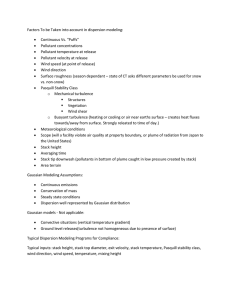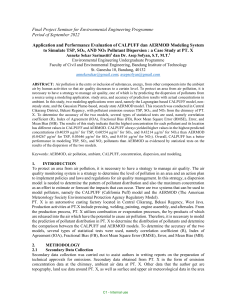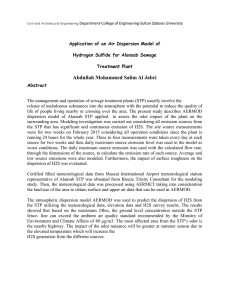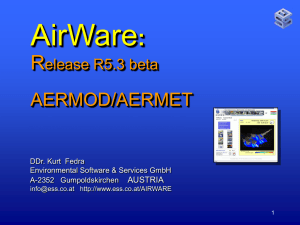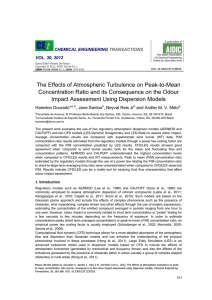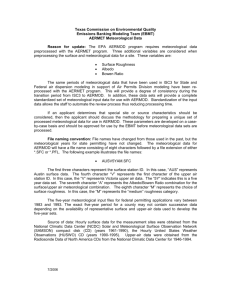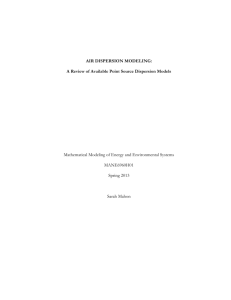CALPUFF & AERMOD Modeling: Air Pollutant Dispersion Study
advertisement
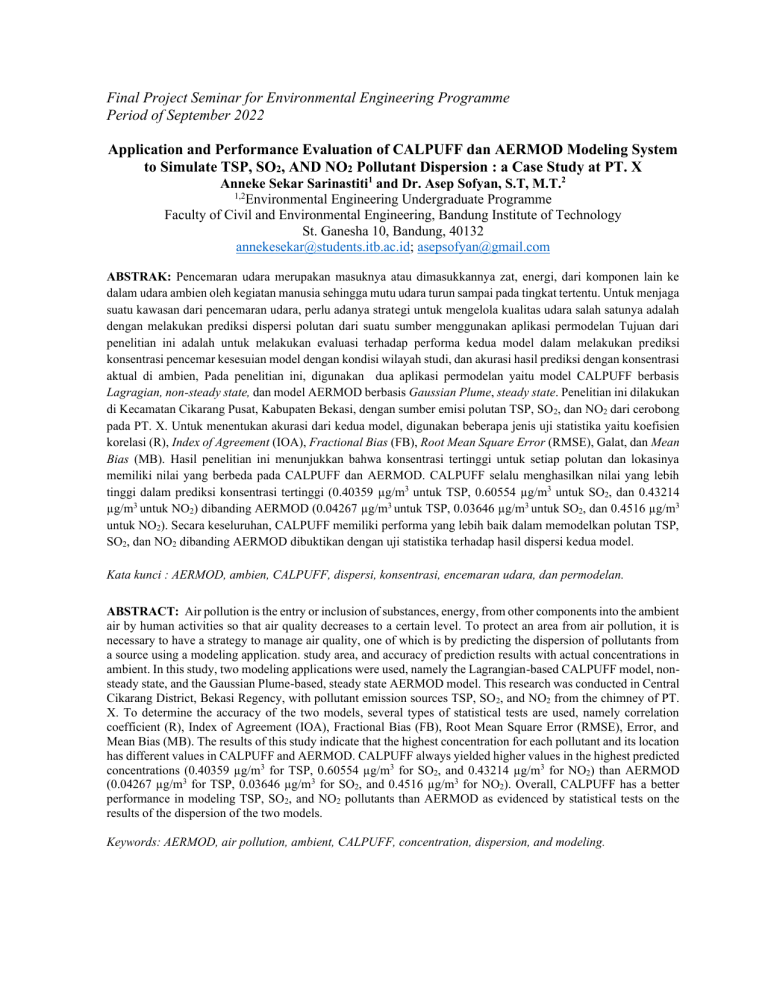
Final Project Seminar for Environmental Engineering Programme Period of September 2022 Application and Performance Evaluation of CALPUFF dan AERMOD Modeling System to Simulate TSP, SO2, AND NO2 Pollutant Dispersion : a Case Study at PT. X Anneke Sekar Sarinastiti1 and Dr. Asep Sofyan, S.T, M.T.2 1,2 Environmental Engineering Undergraduate Programme Faculty of Civil and Environmental Engineering, Bandung Institute of Technology St. Ganesha 10, Bandung, 40132 annekesekar@students.itb.ac.id; asepsofyan@gmail.com ABSTRAK: Pencemaran udara merupakan masuknya atau dimasukkannya zat, energi, dari komponen lain ke dalam udara ambien oleh kegiatan manusia sehingga mutu udara turun sampai pada tingkat tertentu. Untuk menjaga suatu kawasan dari pencemaran udara, perlu adanya strategi untuk mengelola kualitas udara salah satunya adalah dengan melakukan prediksi dispersi polutan dari suatu sumber menggunakan aplikasi permodelan Tujuan dari penelitian ini adalah untuk melakukan evaluasi terhadap performa kedua model dalam melakukan prediksi konsentrasi pencemar kesesuian model dengan kondisi wilayah studi, dan akurasi hasil prediksi dengan konsentrasi aktual di ambien, Pada penelitian ini, digunakan dua aplikasi permodelan yaitu model CALPUFF berbasis Lagragian, non-steady state, dan model AERMOD berbasis Gaussian Plume, steady state. Penelitian ini dilakukan di Kecamatan Cikarang Pusat, Kabupaten Bekasi, dengan sumber emisi polutan TSP, SO 2, dan NO2 dari cerobong pada PT. X. Untuk menentukan akurasi dari kedua model, digunakan beberapa jenis uji statistika yaitu koefisien korelasi (R), Index of Agreement (IOA), Fractional Bias (FB), Root Mean Square Error (RMSE), Galat, dan Mean Bias (MB). Hasil penelitian ini menunjukkan bahwa konsentrasi tertinggi untuk setiap polutan dan lokasinya memiliki nilai yang berbeda pada CALPUFF dan AERMOD. CALPUFF selalu menghasilkan nilai yang lebih tinggi dalam prediksi konsentrasi tertinggi (0.40359 µg/m3 untuk TSP, 0.60554 µg/m3 untuk SO2, dan 0.43214 µg/m3 untuk NO2) dibanding AERMOD (0.04267 µg/m3 untuk TSP, 0.03646 µg/m3 untuk SO2, dan 0.4516 µg/m3 untuk NO2). Secara keseluruhan, CALPUFF memiliki performa yang lebih baik dalam memodelkan polutan TSP, SO2, dan NO2 dibanding AERMOD dibuktikan dengan uji statistika terhadap hasil dispersi kedua model. Kata kunci : AERMOD, ambien, CALPUFF, dispersi, konsentrasi, encemaran udara, dan permodelan. ABSTRACT: Air pollution is the entry or inclusion of substances, energy, from other components into the ambient air by human activities so that air quality decreases to a certain level. To protect an area from air pollution, it is necessary to have a strategy to manage air quality, one of which is by predicting the dispersion of pollutants from a source using a modeling application. study area, and accuracy of prediction results with actual concentrations in ambient. In this study, two modeling applications were used, namely the Lagrangian-based CALPUFF model, nonsteady state, and the Gaussian Plume-based, steady state AERMOD model. This research was conducted in Central Cikarang District, Bekasi Regency, with pollutant emission sources TSP, SO 2, and NO2 from the chimney of PT. X. To determine the accuracy of the two models, several types of statistical tests are used, namely correlation coefficient (R), Index of Agreement (IOA), Fractional Bias (FB), Root Mean Square Error (RMSE), Error, and Mean Bias (MB). The results of this study indicate that the highest concentration for each pollutant and its location has different values in CALPUFF and AERMOD. CALPUFF always yielded higher values in the highest predicted concentrations (0.40359 µg/m3 for TSP, 0.60554 µg/m3 for SO2, and 0.43214 µg/m3 for NO2) than AERMOD (0.04267 µg/m3 for TSP, 0.03646 µg/m3 for SO2, and 0.4516 µg/m3 for NO2). Overall, CALPUFF has a better performance in modeling TSP, SO2, and NO2 pollutants than AERMOD as evidenced by statistical tests on the results of the dispersion of the two models. Keywords: AERMOD, air pollution, ambient, CALPUFF, concentration, dispersion, and modeling. 1. INTRODUCTION Air pollution is the entry or inclusion of substances, energy, from other components into ambient air by human activities so that air quality drops to a certain level which causes ambient air to be unable to fulfill its function (PP No. 41 of 1999 concerning Air Pollution Control). To protect an area from air pollution, it is necessary to have a strategy to manage air quality. The air quality monitoring system is a strategy to determine the level of pollution in an area and an action plan to implement policies and laws and regulations for air quality management. In this strategy, a dispersion model is needed to determine the pattern of pollutant distribution and also the maximum concentration as an effort to estimate or forecast the impacts that can occur. There are two systems that can be used to model polluters, namely the CALPUFF (California Puff) model and the AERMOD (The American Meteorology Society Environmental Protection Agency Regulatory Model). CALPUFF uses a non-steady state approach that takes into account the effects of spatial changes and meteorological components and surface characteristics. AERMOD is a Gaussian plume model-based software recommended by the US EPA for air quality simulation (EPA, 2005; Rood, 2014). AERMOD uses a steady state approach that can include complete climate data such as the planetary boundary layer (PBL). PT. X is an automotive casting factory located in Central Cikarang, Bekasi Regency, West Java. Production activities at PT.X include pressing, welding, painting, engine assembly, and aftersales. From the production process, PT. X utilizes combustion or evaporation processes, the by-products of which are released into the air which have the potential to cause air pollution. Therefore, it is necessary to model the prediction of pollutant distribution in PT. X to determine the distribution of pollutants and determine the comparison between the CALPUFF and AERMOD models. To determine the accuracy of the two models, several types of statistical tests were used, namely correlation coefficient (R), Index of Agreement (IOA), Fractional Bias (FB), Root Mean Square Error (RMSE), Error, and Mean Bias (MB). 2. OBJECTIVE The purpose of this study was to identify the sources of pollution in PT. X, predicting the distribution of pollutants in PT. X using CALPUFF and AERMOD software, determine the comparison of the distribution and the ability of the two applications in modeling, determine recommendations for using the model according to the geographical and meteorological conditions of the research location. 3. METHODOLOGY 3.1 Secondary Data Collection Secondary data collection was carried out to assist authors in writing reports on the preparation of technical approvals for emissions. Secondary data obtained from PT. X in the form of emission concentration data at the chimney, ambient air data at PT. X. Table 3.1 shows the chimney data of PT. X. and Table 3.2 shows emission data from PT. X. Table 3.1 Chimney Data of PT. X Tabel 3.2 Emission Data of PT. X Other data that the author get are topography, land use data around PT. X, as well as surface and upper air meteorological data in the area around PT. X. Topographic data is obtained through the website www.src.com, meteorological data is obtained through the website www.copernicus.com, and land use data is obtained from global land uses. 3.2 Calculation of Emission Rate Determination of emission rate is an early stage before conducting modeling. Emission rate is an important factor that affects the value and pattern of pollutant concentration produced 3.2.1 Calculation of Average Wind Speed Before calculating the emission rate, it is necessary to calculate the peak speed of the chimney first, which requires wind speed data from the research location. The average wind speed of the study area is determined as follows: 𝑎𝑣𝑔 𝑤𝑖𝑛𝑑 𝑠𝑝𝑒𝑒𝑑 (𝑚𝑒𝑑𝑖𝑎𝑛 𝑣𝑎𝑙𝑢𝑒 1 𝑥 % 𝑜𝑓 𝑤𝑖𝑛𝑑 1) + (𝑚𝑒𝑑𝑖𝑎𝑛 𝑣𝑎𝑙𝑢𝑒 2 𝑥 % 𝑜𝑓 𝑤𝑖𝑛𝑑 2) + (𝑚𝑒𝑑𝑖𝑎𝑛 𝑣𝑎𝑙𝑢𝑒 2 𝑥 % 𝑜𝑓 𝑤𝑖𝑛𝑑) = % 𝑡𝑜𝑡𝑎𝑙 𝑤𝑖𝑛𝑑 𝑝𝑒𝑟𝑐𝑒𝑛𝑡𝑎𝑔𝑒𝑠 The average wind speed obtained is 4.52 m/s. 3.2.2 Calculation of Top Chimney Velocity and Emission Rate Gaussian equations are used to determine stack peak velocity and emission rate. The chimney peak velocity is obtained through the following equation. 𝑈2 𝑧2 𝑝 =( ) 𝑈1 𝑧1 Based on the calculation, the peak velocity of the chimney is 4.77 m/s for scrubber, 4.1 m/s for Dust Collector 1, and 4.61 um/s for Dust Collector 2. Emission rate of each stacks can be calculated after getting the top speed at each stack, through the following equation. 𝐸𝑚𝑖𝑠𝑠𝑖𝑜𝑛 𝑟𝑎𝑡𝑒 = 𝐶 1 2 4×𝜋×𝑑 ×𝑣 Based on the calculation, the velocity at each stack is 2.44 mg/s, 0.38 mg/s, and 0.29 mg/s at the scrubber stack, 0.73 mg/s, 1.89 mg/s, and 1.54 mg/s at dust collector stack 1, and 0.55 mg/s, 0.67 mg/s, and 0.53 mg/s at dust collector stack 2, for pollutants TSP, SO2, and NO2. 3.3 Determination of Study Area Grid The study area grid determination is needed to limit the distance over which the pollutant will be modeled. In this study, a grid of 120 km x 80 km was used with a length of 1 km for each grid. 3.4 Pollutant Dispersion Modeling Using CALPUFF dan AERMOD The collected data was processed using the CALPUFF AERMOD modeling application. Table 3.6 shows the differences in input data for CALPUFF and AERMOD. Tabel 3.6 Differences in input data on CALPUFF and AERMOD In general, the data entered into the two models have the same criteria so that the different variables are only the result of the dispersion of the two models. The main difference in entering input data in both models is that the user needs to prepare all input data in CALPUFF before the process continues to the next processor, while empty input data in AERMOD can be overcome by using the menu to create and generate the data. All missing data parameters can be automatically calculated on AERMOD. Another difference lies in the technical input of data input. In CALPUFF, the user needs to do the processing in stages because the output of the first stage is the input for the next stage. In AERMOD, the user can choose which stage to do first. Therefore, using AERMOD is easier and faster than using CALPUFF. 4. ANALYSIS AND DISCUSSION 4.1 Calculation Results Table 4.1 shows the results of the emission dispersion of TSP, SO2, and NO2 and the maximum concentration received by the receptor in the period of 1 and 24 hours. Table 4.1 The results of the emission dispersion of TSP (left), SO2 (right), and NO2 (bottom) and the maximum concentrations received by receptors on CALPUFF and AERMOD Figure 4.1 shows the mapping of the final concentration and ambient concentration of each pollutant for the CALPUFF and AERMOD models. Final and Ambien Concentration of SO2 Final and Ambient Concentration of TSP Concentration (µg/m3) 120 100 Concentration (µg/m3) 100 80 60 40 CALPUFF 20 AERMOD Data Ambien 0 0 1 2 3 4 5 6 CALPUFF 80 AERMOD Data Ambien 60 40 20 0 Sampling Point 0 1 Sampling Point 2 3 4 5 6 Final and Ambient Concentration of NO2 Concentration (µg/m3) 70 60 CALPUFF AERMOD Data Ambien 50 40 30 20 10 0 0 1 2 3 4 5 6 Sampling Point Figure 4.1 Graph mapping the final concentration and ambient pollutant concentrations of TSP (left), SO2 (right), and NO2 (bottom) on the CALPUFF and AERMOD models In Figure 4.1, it can be seen that all final concentrations of dispersion have values that are generally smaller than the ambient data. This can be caused by the use of background concentration data that is not in accordance with the actual background concentration. Due to the limited background concentration data sources, the background concentration data used are not entirely correct at the monitoring location used so that the values may differ from actual conditions. In addition, different actual background concentration conditions may be caused by location, meteorological conditions, regional development projections, topography, land use, emission sources, other pollutants in ambient air, and other factors that have a direct influence on the final dispersion result. In addition, the existence of emission sources other than PT. X as well as biogenic and natural emissions at the research site which are not considered in the modeling can also cause dispersion results that are not in accordance with ambient conditions (Kesarkar et al., 2007). It is seen that the TSP concentration curve has the same pattern whereas the ambient air concentration increases, the final dispersion concentration also increases. Likewise, when the ambient concentration decreases, the final dispersion concentration also decreases. The same pattern also occurs in the SO 2 pollutant mapping curve. However, this pattern was not found in the NO2 pollutant curve. At monitoring point 3 in Figure 4.1, there is an outlier where the final concentration of the dispersion decreases as the concentration in the ambient air increases. This condition can be caused by several things such as incomplete meteorological data at that point during monitoring time, or differences in background concentration which causes the final dispersion results to have far differences. But overall, the CALPUFF model is considered to still be able to predict well according to the pattern in the ambient air even though the final concentration and dispersion have very large differences in value, CALPUFF and there are also outliers in NO2 pollutants. One of the causes of the deviation of the final concentration from the above data with ambient air is due to the incompleteness of the emission source data (Im U., Yenigun O, 2005). A perfect modeling and producing precise pollutant predictions according to ambient data depends on the accuracy of the emission inventory data of the plant concerned and the level of precision of the meteorological and topographical data at the study site. Deviations that occur in the validation test of the Gauss model can be caused by the research location having a complex topography while Gauss's ability is limited to uncomplicated terrain. This happens because it has a Gaussian Plume base in steady state conditions so it does not consider changes in meteorological and field conditions in units of space and time. As a result, the AERMOD model is not suitable for use in research sites with complex terrain, changing meteorological conditions because the results will have values that are far from the ambient data. This is in accordance with the terrain conditions in Bekasi Regency which have different land heights with a range of 3-40 meters above sea level so that the Bekasi Regency terrain becomes complex. (BPS Bekasi Regency, 2022). In particular, Cikarang Sub-district in Bekasi Regency has a topography of 15-46 mdpl, so that the meteorological data available under these conditions is highly variable. This condition explains the deviation of the final concentration values in AERMOD and CALPUFF. Meteorological conditions can also cause data deviation on AERMOD, where AERMOD cannot model pollutants with wind speeds <1 m/s (Masuraha, 2006). Based on surface meteorological data, there are winds with a speed of <1 ms which are called calm winds as much as 2% during the research period. This condition can explain the deviations made by the AERMOD model in modeling the three types of pollutants at PT. X. 4.2 Statistics Test After that, several statistical tests were conducted to determine the error and accuracy of the two models in predicting pollutant concentrations and determine which model is more accurate. The following is the equation used in this study to perform statistical tests. 2 𝐼𝑂𝐴 = 1 − ∑𝑁 𝑖=1(𝐶𝑝𝑟𝑒𝑑,𝑖 − 𝐶𝑜𝑏𝑠,𝑖 ) ∑𝑁 𝑖=1(|𝐶𝑝𝑟𝑒𝑑,𝑖 − 𝐶𝑎𝑣𝑔𝑜𝑏𝑠 | + |𝐶𝑜𝑏𝑠,𝑖 − 𝐶𝑎𝑣𝑔𝑜𝑏𝑠 |) Ideal value = >0.5 𝑅= ∑𝑁 𝑖=1(𝐶𝑝𝑟𝑒𝑑,𝑖 − 𝐶𝑎𝑣𝑔𝑝𝑟𝑒𝑑 ) × (𝐶𝑜𝑏𝑠,𝑖 − 𝐶𝑎𝑣𝑔𝑜𝑏𝑠 ) 2 𝑁 2 √∑𝑁 𝑖=1(𝐶𝑝𝑟𝑒𝑑,𝑖 − 𝐶𝑎𝑣𝑔𝑝𝑟𝑒𝑑 ) × ∑𝑖=1(𝐶𝑜𝑏𝑠,𝑖 − 𝐶𝑎𝑣𝑔𝑜𝑏𝑠 ) Ideal value = close to 1 𝐹𝐵 = Ideal value = -0.7 to 0.7 2 2 (𝐶𝑎𝑣𝑔𝑜𝑏𝑠 − 𝐶𝑎𝑣𝑔𝑝𝑟𝑒𝑑 ) 𝐶𝑎𝑣𝑔𝑝𝑟𝑒𝑑 + 𝐶𝑎𝑣𝑔𝑜𝑏𝑠 𝐸𝑟𝑟𝑜𝑟 = | 𝐶𝑜𝑏𝑠 − 𝐶𝑝𝑟𝑒𝑑 | × 100% 𝐶𝑜𝑏𝑠 𝑛 1 𝑅𝑀𝑆𝐸 = √ ∑ (𝐶𝑝𝑟𝑒𝑑 − 𝐶𝑜𝑏𝑠 )2 𝑛 𝑖=1 𝑛 1 𝑀𝐵 = ∑ (𝐶𝑝𝑟𝑒𝑑 − 𝐶𝑜𝑏𝑠 ) 𝑛 𝑖=1 Data for statistical test is the final concentration of dispersion data by CALPUFF and AERMOD and ambient air concentration. Statistical tests were carried out by comparing the final concentration of the dispersion with the concentration in ambient air at the same coordinate point. The statistical test shows that CALPUFF has a higher accuracy than AERMOD in predicting the concentration for each pollutant, as evidenced by the statistical test value of CALPUFF which tends to be higher than AERMOD. 5. CONCLUSION Based on the research conducted, it can be concluded as follows: 1. CALPUFF has a Lagrangian non-steady state basis while AERMOD has a Gasussian Plume steady state basis so that the difference in the prediction results of concentrations in the air. 2. CALPUFF is able to model concentration predictions more accurately than AERMOD because CALPUFF pays attention to the reaction of each particle after it is dispersed, takes into account variations in meteorological and topographical conditions in the study area at the time of observation, is able to make predictions at each point and at certain hours, and takes into account the presence of calm winds at the time of observation. 3. The statistical test proves that CALPUFF has more capabilities than AERMOD because the test results are higher than the AERMOD test results. 6. REFERENCES Assomadi, Abdu. 2016. Air Pollutant Dispersion Model. Surabaya: ITS Environmental Engineering Study Program. Ahrens, DC 2009. Essentials of Meteorology: An Invitation to the Atmosphere. USA: Bros. Central Bureau of Statistics (BPS) Bekasi Regency. 2022. Bekasi Regency in Figures. Jakarta: Central Bureau of Statistics Engineering and Scientific Consulting. 2011. CALPUFF Modeling System Version 6 User Instruction Government Regulation Number 41 of 1999 on Air Pollution Control. Government Regulation of the Republic of Indonesia Number 101 of 2014 concerning Management of Hazardous and Toxic Waste. Kesarkar et al. 2007. Weather Research and Forecasting Model with AERMOD for pollutant dispersion modeling. A case study for PM10 dispersion over Pune, India. Atmospheric Environment. DOI:10.1016/j.atmosenv.2017 Law of the Republic of Indonesia Number 32 of 2009 concerning Environmental Protection and Management Life. Law No. 23 of 1997 concerning Environmental Management. Regulation of the State Minister of the Environment of the Republic of Indonesia Number 22 of 2021 concerning the Implementation of Environmental Protection and Management. Masuraha and Anand. 2006. Evaluation of the AERMOD Model and Examination of Required Length of Meteorological Data for Computing Concentrations in Urban Areas. University of Toledo : 2006. Regulation of the State Minister of the Environment of the Republic of Indonesia Number 12 of 2010 concerning the Implementation of Air Pollution Control in Regions Regulation of the State Minister for the Environment of the Republic of Indonesia Number 5 of 2021 concerning Procedures for Issuing Technical Approval and Operational Eligibility Letters for Environmental Pollution Control. Models. Rodhe, H., Grandell, J. 1972. The removal time of aerosol particles from the atmosphere by precipitation scavenging. USA: Tellus 24 442. Rood, Arthur S. 2014. Performance Evaluation of AERMOD, CALPUFF, and Legacy Air Dispersion Models Using the Winter Validation Tracer Study Dataset. https://doi.org/10.1016/j.atmosenv.2014.02.054. United States Environmental Protection Agency. 2005. Air Quality Dispersion Modeling – Alternative Models.
